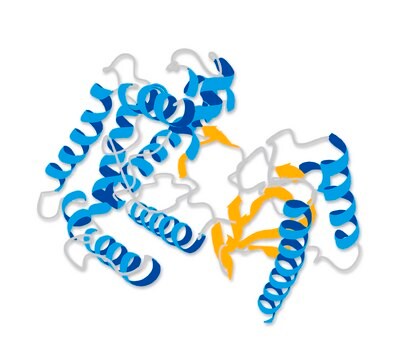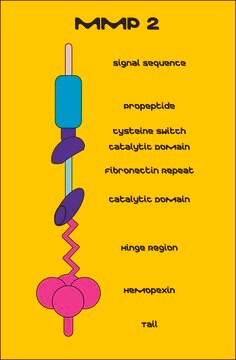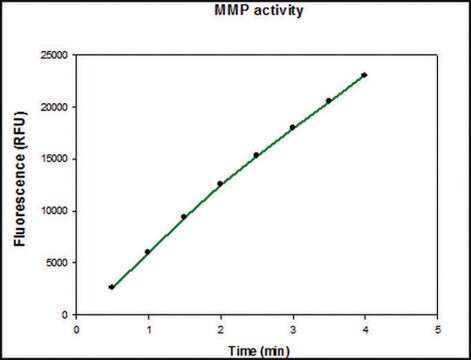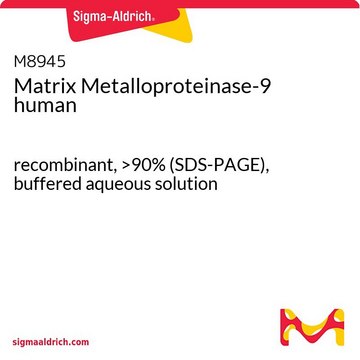SAE0175
MMP-2 pre-activated human
recombinant, ≥1,000 pmol/min/μg, expressed in HEK 293 cells
Sinônimo(s):
72 kDa gelatinase, Gelatinase A, MMP-2, Matrix metalloproteinase-2, TBE-1
Faça loginpara ver os preços organizacionais e de contrato
About This Item
Código UNSPSC:
12352202
NACRES:
NA.32
Produtos recomendados
recombinante
expressed in HEK 293 cells
Nível de qualidade
atividade específica
≥1000 pmol/min-μg
Condições de expedição
dry ice
temperatura de armazenamento
−70°C
Descrição geral
Matrix Metalloproteinase-2 (MMP-2) is a member of the matrix metalloproteinase (MMP) family of proteins. MMPs participate in the breakdown of extracellular matrix in normal physiological processes like embryonic development, reproduction, and tissue remodeling, as well as in disease processes such as arthritis and metastasis. MMP-2 cleaves many substrates, including extracellular matrix components (collagens, fibronectin, and elastin), soluble metabolic mediators (e.g., apolipoproteins), secreted and extracellular matrix-anchored growth factors, and cytokines.
Along with MMP-9, MMP-2 is involved many pathophysiological processes, including leukocyte migration from the circulation into the tissue during inflammation, Chagas′ Cardiomyopathy, heart failure and chronic kidney disease. MMP-2 thus may be regarded as a potential therapeutic target.
As with most MMPs, MMP-2 is secreted as an inactive pro-protein, which becomes activated when cleaved by extracellular proteinases. This product was pre-activated in vitro using 4-aminophenylmercuric acetate (APMA). Thus, it is active and ready for use. The highly toxic APMA was removed from the final preparation.
This product is expressed in human HEK 293 cells as a glycoprotein with a calculated molecular mass of 72 kDa (amino acids 110-660). The DTT-reduced protein migrates as a 75-80 kDa polypeptide on SDS-PAGE because of glycosylation. This protein is produced in human cells, without the use of serum. The human cells expression system allows human like glycosylation and folding, and often supports higher specific activity of the protein. This recombinant protein is expressed without artificial tags.
Along with MMP-9, MMP-2 is involved many pathophysiological processes, including leukocyte migration from the circulation into the tissue during inflammation, Chagas′ Cardiomyopathy, heart failure and chronic kidney disease. MMP-2 thus may be regarded as a potential therapeutic target.
As with most MMPs, MMP-2 is secreted as an inactive pro-protein, which becomes activated when cleaved by extracellular proteinases. This product was pre-activated in vitro using 4-aminophenylmercuric acetate (APMA). Thus, it is active and ready for use. The highly toxic APMA was removed from the final preparation.
This product is expressed in human HEK 293 cells as a glycoprotein with a calculated molecular mass of 72 kDa (amino acids 110-660). The DTT-reduced protein migrates as a 75-80 kDa polypeptide on SDS-PAGE because of glycosylation. This protein is produced in human cells, without the use of serum. The human cells expression system allows human like glycosylation and folding, and often supports higher specific activity of the protein. This recombinant protein is expressed without artificial tags.
Características e benefícios
- Highly purified protein without artificial fusion tags
- Expressed in human cells (HEK 293) for proper glycosylation
- Pre-activated and ready to use
- High substrate activity
forma física
This product is supplied as a 0.22 μm-filtered solution, containing 20 mM Trizma®, pH 7.5, containing 8 mM CaCl2, 119 mM NaCl, 20% glycerol, and 0.05% Brij® 35.
Armazenamento e estabilidade
Store the product at –70 °C. The product retains its activity for at least 2 years as supplied. After initial thawing, it is recommended to store the protein in working aliquots at –70 °C.
Outras notas
This product was pre-activated in vitro using 4-Aminophenylmercuric acetate (APMA). Thus, it is active and ready for use. In order to save our customers from handling hazardous materials, and for environmental saving, the highly toxic and fatal APMA was removed from the final preparation.
Informações legais
Brij is a registered trademark of Croda International PLC
Trizma is a registered trademark of Merck KGaA, Darmstadt, Germany
Exoneração de responsabilidade
This product is for R&D use only. Not for drug, household, or other uses. Please consult the Safety Data Sheet for information regarding hazards and safe handling practices
Código de classe de armazenamento
12 - Non Combustible Liquids
Classe de risco de água (WGK)
WGK 1
Ponto de fulgor (°F)
Not applicable
Ponto de fulgor (°C)
Not applicable
Escolha uma das versões mais recentes:
Certificados de análise (COA)
Lot/Batch Number
It looks like we've run into a problem, but you can still download Certificates of Analysis from our Documentos section.
Se precisar de ajuda, entre em contato Atendimento ao cliente
Já possui este produto?
Encontre a documentação dos produtos que você adquiriu recentemente na biblioteca de documentos.
M-J Hannocks et al.
Matrix biology : journal of the International Society for Matrix Biology, 75-76, 102-113 (2017-11-22)
This review focuses on the complementary roles of MMP-2 and MMP-9 in leukocyte migration into the brain in neuroinflammation, studied mainly in a murine model of experimental autoimmune encephalomyelitis (EAE) that has similarity to the human disease multiple sclerosis. We
Zhengyuan Cheng et al.
International journal of molecular sciences, 18(4) (2017-04-12)
Gelatinases are members of the matrix metalloproteinase (MMPs) family; they play an important role in the degradation of the extracellular matrix (ECM). This effect is also crucial in the development and progression of chronic kidney disease (CKD). Its expression, as
Nossa equipe de cientistas tem experiência em todas as áreas de pesquisa, incluindo Life Sciences, ciência de materiais, síntese química, cromatografia, química analítica e muitas outras.
Entre em contato com a assistência técnica








